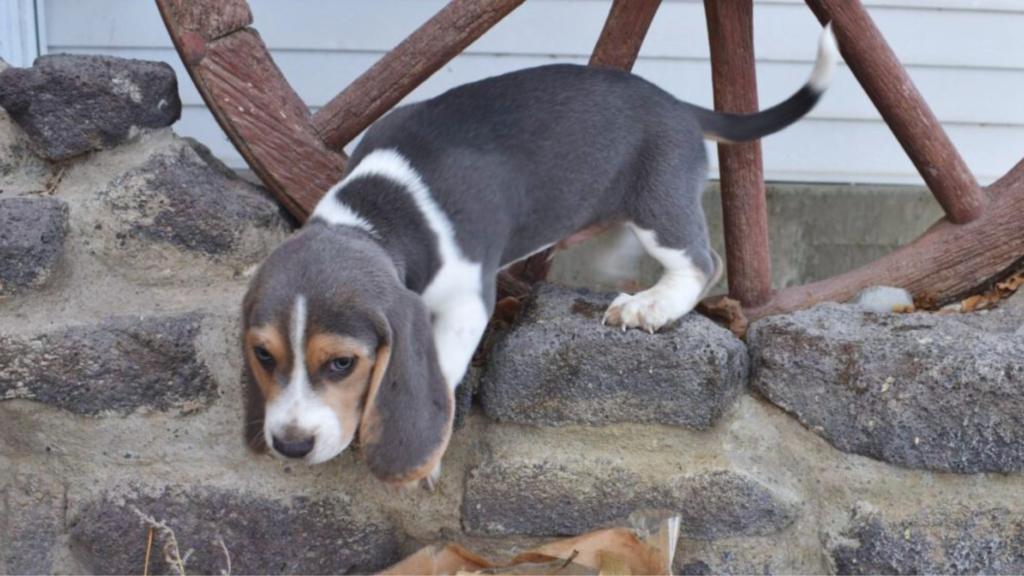Beagles are small to medium hound dogs that are renowned because of their simplicity, good sense of smell, and friendly personality traits. Although beagles initially originated in England to hunt rabbits and small animals like foxes, they have become popular companion dogs. What exactly has made them unique have been their short, silky coats, which come in a variety of colors like tan, black, brown, and white.
The silver Beagle variation is not explicitly mentioned in the provided search results. However, Beagles are known to come in a range of colors, including tricolor and bicolor patterns, with some less common alleles producing non-standard coat colors. The American Kennel Club (AKC) recognizes 11 standard colors and a range of 25 different colors possible for beagles.
History of Beagles
The Beagle breed has a long and varied history that stretches from medieval England. This breed has been selected mostly for its unique sense of smell and its ability for observation. It was developed primarily to hunt smaller game like rabbits and hares.
Origins of the Beagle Breed
They proposed that the Talbot Hound, the St. Hubert Hound, and the Southern Hound are among the different hound breeds from which the Beagle breed originated. Referred to for their strength as well excellent sense of smell, these ancient breeds were used in small-game hunting. It is believed that the Celtic word “beag,” which means “small” or “little,” is where the name “Beagle” came from, referring to the diminutive size of these ancient hunting canines.
Evolution of the Breed Over Time
The Beagle breed experienced substantial modifications and improvements over time. The North Country Beagle and the English Beagle, which were smaller and faster than their predecessors, were developed in England during the 16th century. Reverend Phillip Honeywood was instrumental in the evolution of the contemporary Beagle breed, producing canines with remarkable endurance and scenting skills. Thomas Johnson, who concentrated on breeding dogs with appealing looks, also made contributions to the evolution of the breed.
Popularity of Beagles as Pets
According to the late 1800s and early 1900s, in particular, beagles became increasingly popular as pets. Breed exports to the US and other nations helped the breed gain popularity after the American Kennel Club (AKC) gained an understanding of it in 1885. These days, beagles are known as highly friendly, curious, and energetic animals as well make great friends.
In conclusion, the history of the Beagle breed is extensive and fascinating, spanning several centuries. Hunter requirements and the efforts of powerful breeders have shaped the breed since its inception in medieval England and throughout its evolution. Beagles are beloved pets nowadays, and their specific qualities and skills are recognized.
Characteristics of Beagles
Physical Attributes
Beagles are compact to medium-sized hounds in unique physical traits. They’re distinguished by a large expressive eye, an upright white-tipped tail, as well a while, drooping ears. They have squarish muzzles, a broad nose, an extensive chest, and robust, muscular bodies. The short, silky double coat of beagles comes in a variety of colors; tricolor combinations like black, tan, and white or blue, tan, and white are common. They vary in size according to weight categories, usually weighing across twenty and thirty pounds.
Temperament and Personality Traits
Because of their happy, friendly, and active dispositions, Beagles make popular family pets. Training them needs patience and time because they are perceptive, intelligent dogs that can be obstinate at times. Beagles have a superb sense of smell, making them excellent scent hounds for small animal hunting and detection work in a range of environments. Their remarkable social skills and affectionate nature allow them to quickly build relationships with both people and other dogs, making them the ideal family pet.
Behavioral Characteristics
Beagles are active, fascinated dogs that require a lot of mental and physical stimulation to keep them happy and balanced. Sometimes, their strong hunting instincts can get in the way of their submission, which calls for time-consuming and labor-intensive training. Beagles can be crowded animals, especially when they are following a scent or investigating their environment. They have also been known to perform actions such as wall-jumping and digging under fences for smells. Beagles enjoy cuddling with their human companions and may suffer from separation anxiety as a result of their attachment to their owners.
Silver Beagles: Special Variation
There is no definitive information about a distinct “silver Beagle” variation in the provided search results. However, some key points can be made about Beagle coat colors and color variations:
Definition and Description of Silver Beagles
The term “silver” may sometimes be used to describe a Beagle with a light blue or faded coat color. However, true blue Beagles are extremely rare, as blue is a diluted form of black. For a Beagle to have a further diluted “silver” coat would be incredibly uncommon.
Origin and History of Silver Beagles
The history or provenance of silver Beagles in particular are not covered in the search results, Beagles have been observed to exhibit a range of colors, such as bicolor, tricolor, and solid shades. Over centuries of selective breeding in England, the breed has changed, but there is no mention of the emergence of a silver variation.
Unique Characteristics Compared to Traditional Beagles
There is no information available about how silver Beagles might differ in traits from traditionally colored Beagles, as they are not an understood variation. Beagles are distinguished by their big eyes, floppy ears, and powerful physique in addition to their gregarious, inquisitive, and active dispositions. But a dog’s temperament or skills cannot be determined by its coat color alone.
In conclusion, even though Beagles exhibit a broad spectrum of hues and patterns, there is no proof of a specific “silver Beagle” breed or variation in the search results. A light blue or faded coat may sometimes be described with this term, but this coloration is very uncommon in the breed. To find out if silver Beagles differ in any way from generally colored Beagles, more investigation might be needed.
Health and Care of Silver Beagles
Common Health Issues in Silver Beagles
Silver Beagles, like other Beagles, are generally healthy dogs but can be prone to certain health issues. Some common health problems that can affect Silver Beagles include:
- Steroid responsive meningitis (also known as Beagle pain syndrome)
- Epilepsy (which can be controlled with medication)
- Heart disease
- Eye and back problems
- Mast cell tumors
- Chondroplasia (dwarfism, which can result in warped front legs)
- Obesity (which can lead to other health issues)
This is important to arrange regular checkups with a vet in order to recognize potential health issues early on and manage them.
Exercise and A nutritious diet requirement
In order to meet their dietary needs, silver beagles require an appropriate diet. These dogs require a lot of exercise to remain in good health because they are active dogs. To avoid being overweight, owners ought to provide their pets only high-quality food and avoid from overeating. Walking, playing, and intellectual stimulation can all count toward the minimum two hours of exercise that Silver Beagles require each day. Given how active they are, it is imperative to give them lots of possibilities to run around and play.
Grooming Needs and Maintenance Tips
The silver beagle’s short coat requires little maintenance because it is smooth, They are easy to groom since they have short, weatherproof fur that keeps them safe from the elements. To keep their coat in good condition, all they require is one weekly grooming session. Furthermore, large expressive eyes that require frequent cleaning to avoid disease and floppy ears are characteristics of silver beagles. Owners should also routinely check for any indications of dental problems and trim their nails.
Conclusion
Recap of the Unique Traits and Qualities of Silver Beagles
Silver Beagles, like their traditional counterparts, exhibit the breed’s signature friendly, playful, and intelligent temperament. Their unique silver or grayish coat coloration sets them apart from the more common tricolor and lemon Beagles. While not a recognized color by major kennel clubs, the silver Beagle is a distinctive and attractive variation within the breed.
Reflection on the Responsibilities of Owning a Silver Beagle
The Silver Beagle’s, or any Beagle’s, ownership entails obligations to maintain their joy, health, as well welfare. This involves providing a healthy diet, consistent exercise, appropriate grooming, and instruction. Beagles are active dogs that need to exercise for at least two hours every day to maintain their physical and mental health. Regular veterinary checkups are crucial because they are susceptible for specific medical conditions like hip dysplasia, cherry eye, and epilepsy.
Final Thoughts on the Significance of Preserving and Cherishing This Distinct Breed Variant
The variety and individuality of the Beagle breed are preserved when the Silver Beagle variation is valued and preserved. We can make sure that Silver Beagles remain as cherished companions by encouraging moral breeding practices and responsible ownership that puts the health and well-being of these dogs first. For these dogs’ social security and the breed’s survival, it is essential to adopt from reliable breeders and provide them with a loving home.

